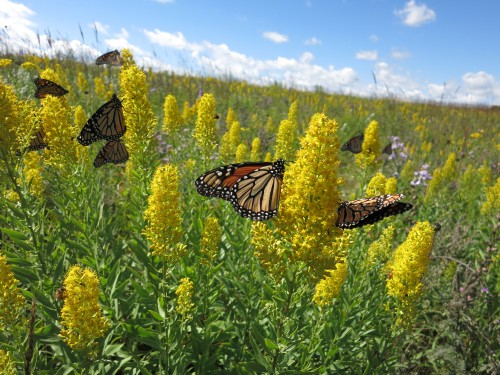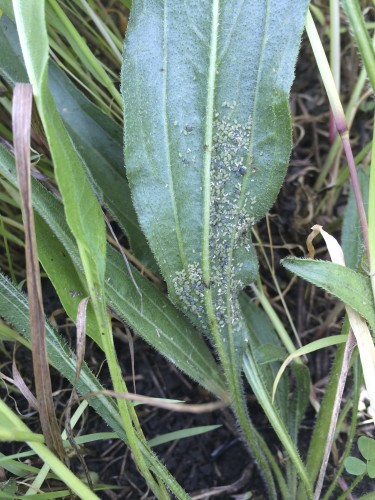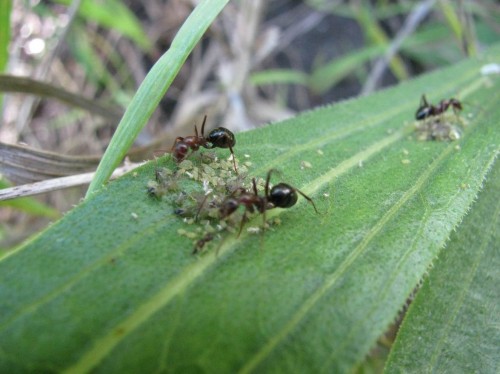|
|

Description: In 2014, Alli Grecco developed and implemented a project to characterize the composition and abundance of plants that flower in 5 remnant prairie Echinacea populations. During her community surveys, Grecco identified 32 co-flowering species. This dataset will be used to describe variation in flowering communities both between and within sites over time.
Start year: 2014
Location: SPP, NWLF, EELR, ALF, NNWLF
Products: Preliminary dataset is located in Alli Grecco’s Dropbox folder. Dataset needs to be made readyR.
 This collection plant had some of the most aphids we’ve seen yet in one place!
Aphis echinaceae is a recently-discovered aphid species believed to specialize on Echinacea angustifolia. In 2014, Cam Shorb designed and implemented an experiment to test whether aphids could survive on the closely related Echinacea pallida or hybrids of the two Echinacea species. He added a total of 1600 aphids to 88 Echinacea plants at Hegg Lake WMA. Although the aphid survival rate was only 9 percent, Aphis echinaceae survived on all Echinacea variants suggesting the aphid may be more flexible than previously believed.
Start year: 2014
Location: Hegg Lake WMA
Products: A preliminary dataset is located in Cam Shorb’s Dropbox folder. This dataset needs to be made readyR.

With over 15 years of data, the study of Echinacea demography is among the Echinacea Project’s longest running research projects. During demography, Team Echinacea maps and collects basic demographic information about plants within 30 prairie remnants. In 2014 we collected demographic information for over 500 individual plants including 179 flowering plants at our largest site, Staffanson Prairie Preserve, alone. Across the other 29 sites, we found 897 flowering plants and visited a total of 1226 plants. For each plant visited, we recorded whether the plant was alive, whether the plant was flowering, and how many flowering heads it produced. With this extensive dataset, we hope to explore inter-annual flowering patterns, assess longitudinal plant fitness, and monitor numerical population dynamics in remnant populations of Echinacea.
Read previous posts about this experiment.
Start year: 1995
Location: 30 remnants prairies
Products: Stuart, Jared, and Gretel are working to clean, organize, and integrate demography, survey, and phenology data (project “demap”). Also see the demography protocol.
Overlaps with: fire and flowering at SPP

To examine the role flowering phenology plays in the reproduction of Echinacea angustifolia, Jennifer Ison planted experimental plot 2 (P2) in 2006 with 3961 individuals selected for extreme (early or late) flowering phenology. In 2014, we measured traits for all 2123 living plants and monitored the daily phenology of 247 flowering heads. Echinacea flowering began on July 2 in P2 and continued through August 24. Using the phenological and trait data collected this summer, we will explore how flowering phenology influences reproductive fitness and estimate the heritability of flowering time in Echinacea angustifolia.
Read previous posts about this experiment.
Start year: 2006
Location: experimental plot 2 (Hegg Lake WMA)
Overlaps with: pollinator efficiency

In 1993, Art retired from the Sears footwear department but he was in no hurry to occupy his spare time until one fateful day at the Chicago Botanic Garden. During this visit, Art asked a volunteer what volunteers at the Garden do. The woman replied, “WE HAVE FUN!” With those three words, Art was convinced and he has since devoted 21 years and over 11,000 volunteer hours to the Chicago Botanic Garden. Art joined the Echinacea Project just over 10 years ago. He primarily weighs achenes to determine whether they contain fertilized embryos (he has weighed more than 100,000 Echinacea achenes!) but Art has also written detailed lab protocols for weighing and x-raying achenes. Outside of his work at the Garden, Art enjoys swimming and gardening.
This is one in a series of profiles recognizing the hard work and dedication of citizen scientists volunteering for the Echinacea Project at the Chicago Botanic Garden.

In 2014, Cam Shorb continued an experiment designed to assess the effects of aphid herbivory on Echinacea angustifolia survival and fitness. The plants are located in experimental plot P1. Cam removed aphids from the 44 plants in the exclusion treatment and added over 220 aphids to the 43 plants in the addition treatment.
Read previous posts about this experiment.
Start year: 2011
Location: P1
Products: Fitness measurements were collected during our annual assessment of fitness in P1. A list of focal plants and addition/exclusion datasheets are located in Cam Shorb’s Dropbox folder.
Overlaps with: Overlaps with: Phenology and fitness in P1

After retiring from a career in which he wore a number of different caps (physicist, mathematician, professor of computer science and rocket scientist to name a few), Lou began volunteering at the Chicago Botanic Garden in 1993. Lou has put the full range of his diverse skillset to use at the Garden. For the Echinacea Project, Lou has written a computer program to mathematically describe flowering phenology in Echinacea, built face shields and scanning trays to help process Echinacea achenes in the lab, and constructed survey grids to help us locate seedlings in the field. Most recently, he created a device to help us calibrate the levels on our GPS units. In his spare time, Lou enjoys woodworking.
This is one in a series of profiles recognizing the hard work and dedication of citizen scientists volunteering for the Echinacea Project at the Chicago Botanic Garden.

Greetings from Chicago Botanic Garden! A new year is upon us and it is time to recap a busy 2014 summer. Over the next several weeks, we will be posting flog updates describing research projects from the summer and the status of the Echinacea Project’s long-term experiments. Stay tuned!
Click here to Browse all of the updates!

After retiring from a career as a preschool teacher, Leslie began volunteering at the Chicago Botanic Garden. Although her initial volunteer work involved maintaining the outdoor gardens, she soon joined the Echinacea Project and has been a member of our volunteer team since 2009. In the lab, Leslie specializes in quality control. She checks each envelope of cleaned Echinacea material to ensure that it will produce clean scans and x-ray images. Leslie is an avid gardener and is currently enrolled in the Illinois Master Gardener course. She also enjoys attending vintage car races with her husband.
This is one in a series of profiles recognizing the hard work and dedication of citizen scientists volunteering for the Echinacea Project at the Chicago Botanic Garden.

Bill, a former state attorney, began volunteering at the Chicago Botanic Garden after his retirement in 2002. In his time at the Botanic Garden, Bill has removed invasive species from the Botanic Garden’s restored habitats, monitored rare plants through the Plants of Concern program, and helped clean and count Echinacea achenes. Since joining the Echinacea Project, he has counted over 340,000 achenes! Outside of the lab, Bill enjoys playing the piano and collecting stamps from around the world.
This is one in a series of profiles recognizing the hard work and dedication of citizen scientists volunteering for the Echinacea Project at the Chicago Botanic Garden.
|
|










